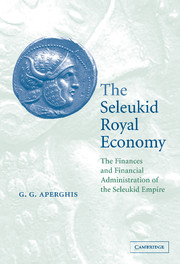Book contents
- Frontmatter
- Contents
- List of figures
- List of tables
- Preface
- List of abbreviations
- Map. The Hellenistic Near East
- Introduction
- Part I PRELIMINARIES
- Part II THE UNDERLYING ECONOMY
- Part III THE ROYAL ECONOMY
- Chapter 7 PS.-Aristotle's Oikonomika, Book 2
- Chapter 8 Revenue
- Chapter 9 The handling of surpluses
- Chapter 10 Expenditure
- Chapter 11 Coinage
- Chapter 12 A model of the Seleukid economy
- Chapter 13 Financial administration
- General conclusions
- Appendix I Coin hoards lists
- Appendix 2 Documents and translations
- References
- Index
Chapter 7 - PS.-Aristotle's Oikonomika, Book 2
from Part III - THE ROYAL ECONOMY
Published online by Cambridge University Press: 22 September 2009
- Frontmatter
- Contents
- List of figures
- List of tables
- Preface
- List of abbreviations
- Map. The Hellenistic Near East
- Introduction
- Part I PRELIMINARIES
- Part II THE UNDERLYING ECONOMY
- Part III THE ROYAL ECONOMY
- Chapter 7 PS.-Aristotle's Oikonomika, Book 2
- Chapter 8 Revenue
- Chapter 9 The handling of surpluses
- Chapter 10 Expenditure
- Chapter 11 Coinage
- Chapter 12 A model of the Seleukid economy
- Chapter 13 Financial administration
- General conclusions
- Appendix I Coin hoards lists
- Appendix 2 Documents and translations
- References
- Index
Summary
Book 2 of the Oikonomika is presented in two sections, as a manual for would-be financial administrators. In the first, the theoretical part (1.1–8), the four types of ‘economies’ are described: royal, satrapal, city and household, along with their constituent elements. ‘Economy’ is, of course, to be understood here in the sense of a sphere of financial administration: a kingdom, a province, a city and its land (chōra) or an individual household (oikos). In the second section, the practical part (2.1–41), a number of financial stratagems of the past are presented, as examples both of ways in which funds were actually collected in times of need and of imaginative financial management. The first section ends with a bridging passage to the second (1.8), which explains why it was thought necessary to add the practical examples to the theoretical discussion.
It is now widely accepted, following van Groningen 1933, that Book 2 was written in the last quarter of the fourth century bc and that it was probably a treatise of an Aristotelian scholar intended to provide instruction on the efficient management of financial matters at different levels. As such, and in line with the Peripatetic school's practical approach to the study of the human and the natural world, it looked for real-life models.
- Type
- Chapter
- Information
- The Seleukid Royal EconomyThe Finances and Financial Administration of the Seleukid Empire, pp. 117 - 136Publisher: Cambridge University PressPrint publication year: 2004
- 1
- Cited by

